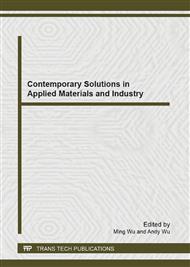[1]
J. Eisenman, Dynamic wheel load fluctuations-road stress, Strasse und Autobahn, 4 (1975) 127-128.
Google Scholar
[2]
D. J. Cole, D. Cebon, Truck suspension design to minimize road damage, Proceedings of the Institution of Mechanical Engineers, Part D: Journal of Automobile Engineering, 210, 2 (1996) 95-107.
DOI: 10.1243/pime_proc_1996_210_251_02
Google Scholar
[3]
K. B. Todd, B.T. Kulakowski, Simple computer models for predicting ride quality and pavement loading for heavy trucks, Transportation Research Record, 1215 (1989) 137-150.
Google Scholar
[4]
O. Kropác, P. Múcka, Effect of obstacles in the road profile on the dynamic response of a vehicle, proceedings of the institution of mechanical engineers, Part D: Journal of Automobile Engineering, 222, 3 (2008) 353-370.
DOI: 10.1243/09544070jauto387
Google Scholar
[5]
L. Dawei, L. Wei, Dynamic load characteristics of heavy vehicle based on multi-body dynamic model, Transactions of the Chinese Society for Agricultural Machinery, 40, 11 (2009) 7-12.
Google Scholar
[6]
L. Dawei, C. Huanming, L. Wei, Evaluation of road damage based on full heavy vehicle multi-body dynamic model, Journal of Vibration and Shock, 29, 4 (2010) 92-96.
Google Scholar
[7]
J. Rongchao, L. Dawei, Simulation analysis of heavy vehicle dynamic load under road excitation, Journal of Highway and Transportation Research and Development, 29, 5 (2012) 152-158.
Google Scholar
[8]
Z. Yonglin, T. Honghua, Hou Chuanliang, Research and design of time domain simulation system for vehicle road stochastic irregularity, Transactions of the Chinese Society for Agricultural Machinery, 21, 2 (2005) 86-91.
Google Scholar
[9]
Schiehlen, Werner, White noise excitation of road vehicle structures, Sadhana - Academy Proceedings in Engineering Sciences, 31, 4 (2006) 487-503.
DOI: 10.1007/bf02716788
Google Scholar
[10]
L. Sun, Optimum design of road-friendly vehicle suspension systems subjected to rough pavement surfaces, Applied mathematical modeling, 26 (2002) 635-652.
DOI: 10.1016/s0307-904x(01)00079-8
Google Scholar
[11]
L. Dawei J. Rongchao, Parameters identification of rational function power spectral density of pavement based on genetic algorithms, Transactions of the Chinese Society of Agricultural Engineering, 28, 8 (2012) 128-133.
Google Scholar
[12]
H. B. Pacejka, I. J. M. Besselink, Magic Formula tyre model with transient properties, Vehicle System Dynamics, 27, Suppl (1997) 234- 249.
DOI: 10.1080/00423119708969658
Google Scholar


